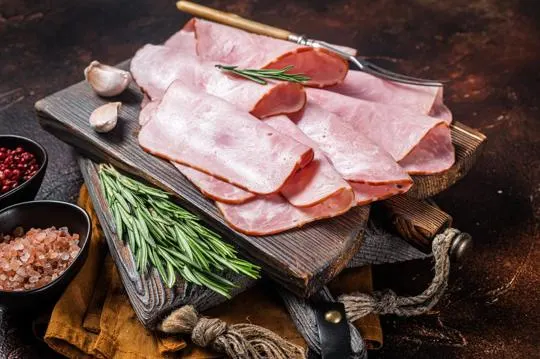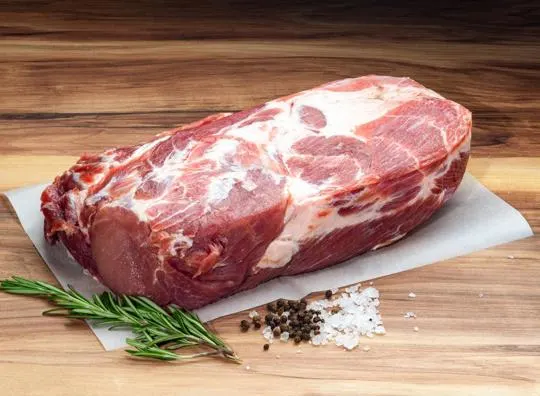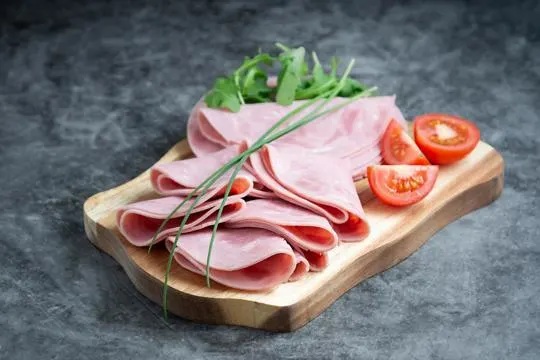Summary of key points
The main difference between pork shoulder and ham is in the cut of meat. Pork shoulder comes from the upper part of the pig’s front leg, while ham comes from the back leg.
This difference also affects the texture and flavor of these cuts. Pork shoulder has more connective tissue, resulting in a tougher texture that is best suited for slow cooking methods like roasting or braising. On the other hand, ham has a leaner and more tender meat that can be sliced and cooked in various ways.
In terms of taste, pork shoulder tends to have a richer and fattier flavor compared to ham.
Ever stood in the meat aisle and scratched your head? Pork shoulder and ham are not twins.
Seriously, they’re from the same glorious creature but play in different leagues. Pork shoulder, folks, is the upper part of the pig’s front leg. It’s versatile. We’re talking roasts, pulled pork, you name it.
Ham? That’s the hind leg. It’s what you probably devour during holidays. Sweet, salty, and oh-so-glorious when glazed.
We once made the rookie mistake of mixing them up. Picture this: a Thanksgiving with pulled…ham. Not our proudest moment.
Remember this, and you’re golden: pork shoulder equals masterpiece in slow cooking; ham equals holiday cheer.
What is Pork Shoulder?

Pork shoulder, also known as pork butt or Boston butt, is a flavorful and versatile cut from the upper shoulder area of the pig.
It has a marbled texture and high-fat content, making it ideal for slow-cooking methods.
This tender, juicy cut is popular in barbecue recipes.
It can be seasoned with rubs or marinades before being cooked low and slow over indirect heat.
This long cooking time renders out the fat and breaks down the collagen, making it succulent and flavorful.
What makes pork shoulder unique is its balance of fat and lean meat.
This combination gives it a rich taste and keeps it moist during cooking.
Plus, the connective tissues within the muscle add extra flavor.
Pork shoulder can be prepared in various ways.
You can leave it whole for large gatherings or events.
Or, you can slice it into chops or steaks for individual portions.
It can also be used in stews, soups, pulled pork sandwiches, and tacos.
What is Ham?

Ham is a meat product made from the hind legs of pigs.
To make it tasty and last longer, it is usually cured or smoked.
This delicacy has been savored globally for centuries.
To cure ham, it is soaked in brine or dry rubbed with salt, sugar, and other seasonings.
This helps draw out moisture and stops bacteria growth.
Then, it is either cooked or smoked, depending on the flavor desired.
It can be enjoyed in many ways, like sliced deli meat, a whole roasted ham for special occasions, or used as an ingredient in recipes.
It gives a salty and savory taste, making it a favorite among culinary aficionados.
What sets ham apart from other pork cuts is its flavor and texture.
It has a sweet and smoky taste from the curing and smoking process.
The texture is tender yet firm, great for slicing or shredding.
Ham also provides several nutritional benefits.
It is a source of high-quality protein and contains essential vitamins and minerals like B6, B12, zinc, and iron.
However, it is high in sodium due to the curing process.
Differences Between Pork Shoulder and Ham

Pork shoulder and ham may seem similar, but they have key differences.
Cut and Source
Pork shoulder and ham are yummy meats with their own tastes and textures.
Pork shoulder comes from the front leg, ham from the hind leg.
Both are popular around the world.
Pork shoulder is full of delicious fat and lean meat, perfect for slow-cooking.
It’s versatile and great in sandwiches or stews.
Ham is saltier thanks to the curing process.
It’s dense and firm, either hot or cold.
It’s often the star of holiday meals and deli platters.
Pork shoulder is easy to find, but ham needs more work.
Quality hind legs must be chosen and curing can take weeks or months.
The effort makes ham’s unique taste and texture possible.
In summary, pork shoulder and ham are both great.
The former is juicy and tender, the latter flavored and versatile.
Enjoy one or both for a great food experience.
Processing and Preparation
Processing and prep are key to telling pork shoulder apart from ham.
Pork shoulder needs trimming of fat, then slow cooking to make it tender.
Ham’s processing involves salting and maybe other seasonings, for flavor and preservation.
Both cuts need careful prep for great taste and texture.
Pork shoulder often gets a marinade or seasoning before cooking.
But ham is usually roasted or baked, giving it a unique flavor and feel.
Knowing the differences in processing and prepping helps pick the right cut for dishes and tastes.
Flavor and Texture
Pork shoulder, or Boston butt, is known for its rich flavor and tender meat.
It has a good amount of fat marbling, making it juicy and melting in your mouth.
Ham, however, is distinct in its smoky and salty taste.
Its texture depends on the type, usually being firmer than pork shoulder.
Both cuts are unique and can be enjoyed in various dishes.
Cooking Methods
Cooking pork shoulder and ham is different.
Pork shoulder, also called Boston butt, is good for slow cooking like braising or roasting.
This tenderizes the meat and makes it flavorful.
Ham is usually cooked by smoking, baking, or boiling.
These methods make the ham taste smoky.
Knowing the right cooking methods helps make the best pork shoulder or ham.
Similarities Between Pork Shoulder and Ham

Pork shoulder and ham, though not the same, have similarities.
Both originate from the pig’s back leg.
Plus, they’re great for a variety of cooking styles.
Culinary Uses for Pork Shoulder and Ham
Pork shoulder and ham both come from the pig, but they have different uses in the kitchen.
Pork shoulder is great for slow cooking or roasting, making juicy pulled pork.
On the other hand, ham is usually cured and smoked, like deli meat or a holiday centerpiece.
Pork shoulder can be used for long cooking techniques, which break down its tough fibers.
This makes it ideal for slow-cooked dishes like pulled pork sandwiches or braised dishes – they become super tender and tasty.
Pork shoulder’s richness goes well with Mexican carnitas or French cassoulet.
Ham is mostly from the pig’s hind leg.
It’s normally cured or smoked, and often cooked before eating.
It has a salty flavor, which complements cheese, bread, and veggies in sandwiches.
Plus, it’s a popular dish at holiday meals when baked or glazed.
Both pork shoulder and ham have special tastes and textures.
From pulled pork tacos to honey-glazed hams, these cuts offer endless possibilities for culinary creations.
Slow-cooked comfort foods or savory cured meats – pork shoulder and ham can satisfy any taste buds.
Conclusion
Ultimately, knowing the difference between pork shoulder and ham can be essential when cooking.
Whether you’re preparing Ham Hock soup, slow-roasted pulled pork shoulder sandwiches, or honey glazed ham for a special occasion, you want to make sure that you are starting with the right ingredient.
Choosing the correct cut of meat in any dish can help take your culinary journey to the next level by elevating both flavor and texture.
Armed with a little knowledge about pork shoulder vs ham, you’ll have all the tools required for endless delicious dishes.
If there’s one thing for certain, it’s that consuming meats from these two cuts will never draw complaints from hungry individuals gathered at the table.
May your mastery of pork shoulder vs ham result in succulent meals and happy bellies.

Leave a comment